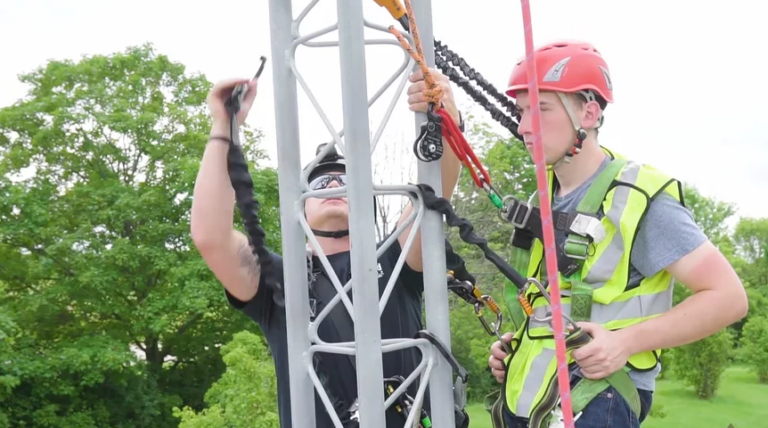Tower rescue is a specialized discipline within the rope rescue industry, focusing on safely evacuating individuals from tall structures such as communication towers, wind turbines, and other elevated platforms. This type of rescue demands advanced skills, specific equipment, and a thorough understanding of various rescue techniques due to the unique challenges posed by these structures.
Key Components:
- Training and Certification:
- Rigorous training is essential, encompassing advanced rope techniques, knot tying, anchor systems, and patient packaging. Certification from bodies like the National Fire Protection Association (NFPA) ensures that rescuers meet industry standards (Rigging Lab Academy) (Rigging Lab Academy).
- Safety Equipment:
- Harnesses and Ropes: Full-body harnesses and high-strength, static ropes are crucial for safety and reliability.
- Anchors and Descending Devices: Secure anchor points and controlled descent devices like figure-eight descenders are necessary for safe operations.
- Personal Protective Equipment (PPE): Helmets, gloves, and other protective gear are essential to guard against falls and environmental hazards (Rigging Lab Academy) (Rigging Lab Academy).
- Rescue Techniques:
- Ascending and Descending: Rescuers must be proficient in techniques for moving up and down the tower using ascenders and descenders.
- Patient Packaging and Hauling Systems: Effective methods for stabilizing and transporting victims, including mechanical advantage systems like pulleys, are vital.
- High-Angle Rescues: Specialized methods for working in vertical or near-vertical environments are necessary for safe rescues (Rigging Lab Academy) (Rigging Lab Academy).
- Communication and Coordination:
- Effective communication is critical, often involving radios and visual signals. Coordination with emergency services ensures comprehensive care for the victim (Rigging Lab Academy) (Rigging Lab Academy).
- Environmental Considerations:
- Rescuers must be prepared for various weather conditions and aware of potential hazards like electrical lines and structural integrity of the tower (Rigging Lab Academy).
Types of Rescues:
- Tower Control vs. Ground Control: Different strategies are used based on whether the rescuer operates from the ground or climbs the structure. Tower control involves rescuers climbing the structure, while ground control relies on systems operated from the ground (Rigging Lab Academy) (Rigging Lab Academy).
- Bottom-Up and Top-Down Rescues: These refer to the direction from which the rescue is initiated, either from below the victim or from above (Rigging Lab Academy).
Applications and Importance:
Tower rescue is critical for industries where workers operate at significant heights, such as telecommunications, wind energy, and construction. Proficient tower rescue teams are essential for preventing serious injuries and fatalities, making continuous training and adherence to safety standards paramount (Rigging Lab Academy) (Rigging Lab Academy).
Courses and Training:
Courses such as those offered by Rigging Lab Academy cover a wide range of topics, from basic climbing techniques to advanced rescue scenarios. These courses are designed for both tower workers and emergency responders, providing comprehensive training in climbing protection, fall protection, and both ground-based and structure-based rescues (Rigging Lab Academy) (Rigging Lab Academy).
By integrating advanced training, specialized equipment, and robust safety protocols, tower rescue operations ensure that individuals working at heights can be safely and effectively rescued in emergency situations.
Peace on your Days
Lance









